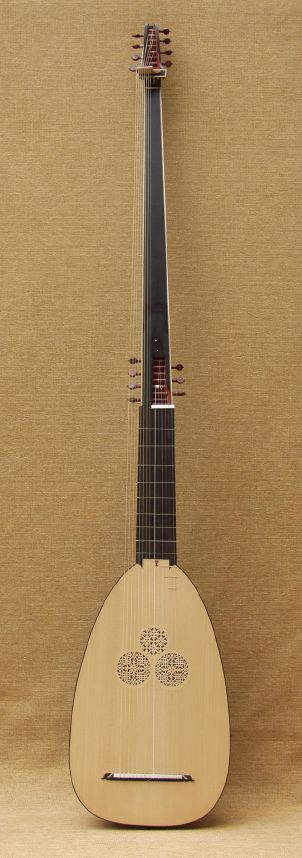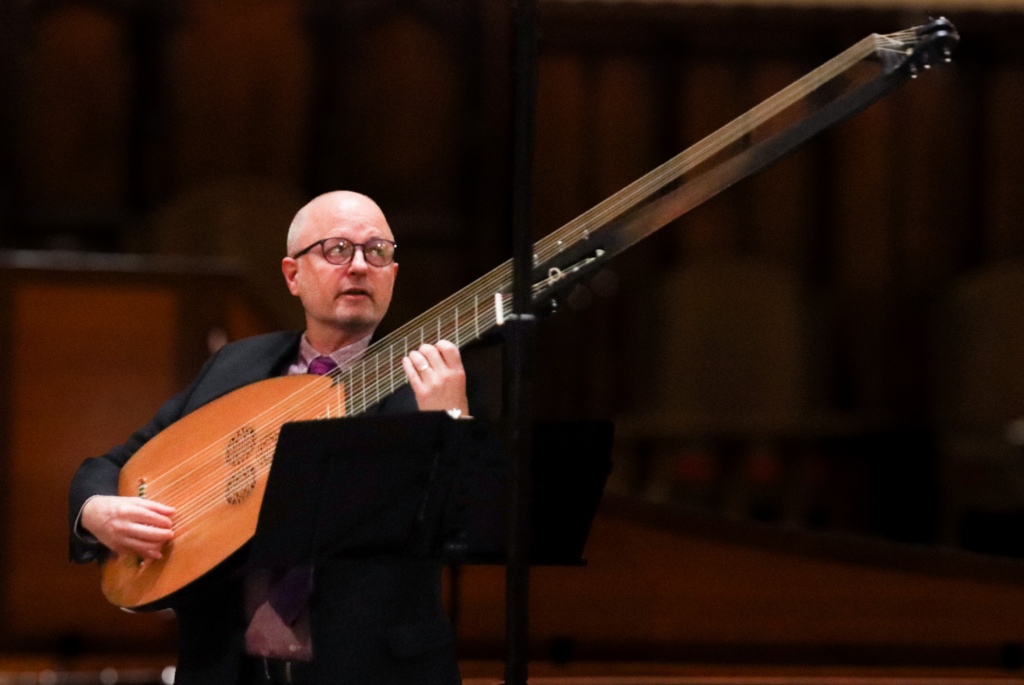
The undisputed giraffe of the baroque orchestra is the theorbo, that double-necked thing that has the body of a lute, is plucked like a lute, but has a ridiculous extension that makes the instrument stick up above people who are standing in the orchestra even when the theorbist (a person playing the theorbo) is seated.
What’s in a Name?
The usual reliable reference sources on words—Oxford English Dictionary, Treccani, Grande dizionario della lingua italiana, Trésor de la Langue Française informatisé—note the etymology for the word “theorbo” as “uncertain”. First attested in Italy in 1586 as la tiorba (ˈtjɔr.ba), the instrument made its way into France where the locals gallicized it as le théorbe (te:ɔʁbə), a spelling that the Germans were perfectly happy to adopt as-is at home: die Theorbe. Across the Channel it got anglicized as theorbo, its final O less a regendering than futher evidence of a British penchant for adding a final O to the names for exotic musical things. For instance, Londoners called the Italian musical form corrente a coranto.
A lute with two necks
A theorbo, as opposed to a lute, has two necks: one fingerboard length and the other typically extending beyond the performer’s arm reach. The fingerboard-length rank has the fretted strings that are plucked with the fingers; the long extension has a rank of strings tuned in a scale that supply the low bass notes. The second neck with long open strings is the defining characteristic of a theorbo, in the broad sense. These strings cannot be fretted but they are plucked with the thumb. These were invented in Italy specifically for for accompanying singers using a performance practice called basso continuo, which combined the composed bass notes with improvised harmonies.
Why are theorbos so much bigger than lutes?
As mentioned above, theorbos were invented to accompany singers. Not just sweet, domestic singing at the fireplace, but projecting, professional public solo- and ensemble singing, e.g. pre-opera monodies and madrigals. It required a louder lute. In order to achieve greater resonance, the garden-variety renaissance lute, with its 55-65 centimeter string length, got tricked out with a longer fingerboard to accommodate string lengths of 80–90 cm.
Resonance achieved, but with consequences. The top two strings could not be tuned in the normal sequence of a renaissance lute, for instance A2 D3 G3 B3 E4 A4 from lowest to highest (the letter indicating the name of the pitch, the number representing in which octave the pitch lies). The tension needed to achieve the two highest pitches exceeded the breaking point of strings. To compensate, the note-name sequence was preserved, but the two highest strings were each dropped an octave, resulting in the sequence A2 D3 G3 B3 E3 A3. This phenomenon of mixed up-and-down tuning is called re-entrant tuning. For such a theorbo in “A” tuning, the strings on the long extension neck were tuned in a scale, descending G2 F2 E2 D2 C1 B1 A1 G1.

Italians called double-neck lutes tuned this way both tiorba or chitarrone, with chitarrone restricted to instruments with this re-entrant tuning. But broadly, any lute with a double neck could be considered a theorbo, without consideration of the fretted strings’ tuning, i.e., re-entrant or otherwise. For instance, while the archlute (arciliuto) has a rank of open bass strings, its fingerboard length allows for a normal, rising sequence of fretted strings. The Italians had a characteristically lovely word for this phenomenon, attiorbato, meaning “theorbized”.
…or is it just a weird guitar
The term chitarrone has no murky etymology. It derives from the Italian word for guitar, chitarra, the ancestry of which traces back to the classical Greek kithara (κιθάρα), the roots of which reach back to pre-Greek sources. Chitarrone‘s -one suffix transforms its host word to mean beyond itself, here an ultra-guitar. That’s because the notes of the chitarrone’s 6th through 2nd courses overlap with the top five courses of a guitar: ADGBE. In the baroque era, professional chitarrone players also played guitar. One of the finest baroque guitarists, Angelo Michele Bartolotti, has several published volumes of guitar music, and some of his theorbo music also survives in manuscript, and it’s at least as good as his guitar music.
FUN FACTS
- The theorbo might look ridiculous, but it is often the loudest single instrument in the band, barring brass instruments.
- Though invented as an accompaniment instrument, theorbo jocks went on to create a small but notable solo repertoire.
- The theorbo is the bain of opera stage directors’ existence because it will be visible from the pit at the singers’ foot level.
Catch Richard and two additional theorbo colleagues in Tempesta’s February 2024 project: Cruel Amaryllis
